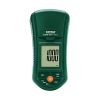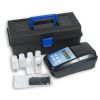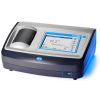Hach 2100Q Portable Turbidity Meter
Features
- Single standard calibration reduces calibration and handling time
- On-screen assisted verification ensures instrument is performing correctly
- RST mode for precise measurement in rapidly settling samples
- Free ground shipping
- Expedited repair and warranty service
- Lifetime technical support
- More
Easy Calibration and Verification
The Hach 2100Q Portable Turbidity Meter provides confidence that measurements are right every time. On-screen assisted calibration and verification save time and ensure accuracy. With an easy-to-follow interface, complicated manuals are not needed to perform routine calibrations. Single-standard RapidCal calibration offers a simplified solution for low-level measurements.
Simple Data Transfer
Data transfer with the Hach 2100Q portable turbidity meter is simple, flexible, and doesn't require additional software when used with the optional USB + Power module. All data can be transferred to the module and easily downloaded to a computer with a USB connection.
Accurate for Rapidly Settling Samples
The Hach 2100Q Portable Turbidity Meter incorporates an innovative Rapidly Settling Turbidity mode to provide accurate, repeatable measurements for difficult-to-measure, rapidly settling samples. An exclusive algorithm that calculates turbidity based on a series of automatic readings eliminates redundant measurements and estimating.
Convenient Data Logging
Up to 500 measurements are automatically stored in the instrument for easy access and backup. Stored information includes date and time, operator ID, reading mode, sample ID, sample number, units, calibration time, calibration status, error messages and the result.
Optical System for Precision in the Field
The two-detector optical system compensates for color in the sample, light fluctuation, and stray light, enabling analysts to achieve laboratory-grade performance on a wide range of samples, even under difficult site conditions.
- Measurement Method: Ratio turbidimetric determination using a primary nephelometric light scatter signal (90) to the transmitted light scatter signal.
- Regulatory: Meets EPA Method 180.1
- Light Source: Tungsten filament lamp
- Range: 0 to 1000 NTU (FNU)
- Accuracy: +/-2% of reading plus stray light from 0 to 1000 NTU
- Repeatability: +/-1% of reading, or 0.01 NTU (FNU), whichever is greater
- Resolution: 0.01 NTU on lowest range
- Stray Light:< 0.02 NTU (FNU)
- Signal Averaging: Selectable on/off
- Detector: Silicon photovoltaic
- Reading Modes (user selectable): Normal (Push to Read); Signal Averaging; Rapidly Settling Turbidity
- Data Logger: 500 records
- Power Requirement: 110-230 VAC, 50/60 Hz (with Power or USB+Power module); 4 AA alkaline batteries; Rechargeable NiMH (for use with USB+Power module)
- Operating Conditions: Temperature: 0 to 50 C (32 to 122 F); Relative Humidity: 0 to 90% @ 30 C, 0 to 80% @ 40 C, 0 to 70% @ 50 C, non-condensing
- Storage Conditions: -40 to 60 C (-40 to 140 F), instrument only
- Interface: Optional USB
- Instrument Enclosure Rating: IP67 (closed lid, battery compartment excluded)
- Protection Class: Power Supply: Class II
- Certification: CE certified
- Sample Required: 10mL (0.3 oz.)
- Sample Cells: 60mm x 25mm (2.36" x 1") borosilicate glass with screw cap
- Dimensions: 22.9cm x 10.7cm x 7.7cm (9.0" x 4.2" x 3.0")
- Weight: 527g (1.16 lb.) without batteries; 618g (1.36 lb.) with four AA alkaline batteries
- (1) 2100Q portable turbidity meter
- (1) Carrying case with insert
- (6) Sample cells
- (1) Sealed vial each of 20, 100 & 800 NTU StablCal primary calibration standards
- (1) 10 NTU primary verification standard
- (1) 15mL bottle of silicone oil
- (1) Sample cell oiling cloth
- (1) Operations manual
- (1) Quick start guide
- (4) AA alkaline batteries
In The News
Covid clears the waters around Key West
In the early days of the Covid-19 pandemic, there was a period of unexpected environmental optimism. Wild goats roamed the streets of a town in Wales after its residents retreated indoors. Air quality improved in metropolises around the world. As shipping paused or slowed down, the oceans were quieter than they have been for some time. Now research shows that water quality improved around Key West, Florida, during 2020, a year in which the Covid-19 pandemic kept people indoors and slowed boat traffic. A Visible Difference Henry Briceño first found out about the clearer water around Key West from locals who noticed a difference. So he decided to check those observations against the data.
Read MoreCharles River Algal Blooms Stop Swimming and Launch a Floating Wetland
The Charles River used to be a swimming hotspot for Cambridge and Boston residents. Decades of industrial pollution and nutrient runoff have degraded water quality and eliminated public swimming in the Lower Charles, but a movement is afoot to get Boston and Cambridge back in the water. One step toward the goal of a safely swimmable river—without the need to obtain a permit, as is now necessary—is detecting and managing the harmful algal blooms that appear on the river. An experimental floating wetland and new research and analysis of water quality data that shows a possible effective detection system for algal blooms on the Charles River are two new steps toward the goal of safe, accessible swimming.
Read MoreManaging Soil Erosion Important Around Construction Sites
On construction sites, project managers sometimes don’t see the value in best management practices that can reduce soil erosion. But that is an important consideration, especially in states like California that have regulations that attempt to prevent the loss of soil. If managers disregard them, they can face hefty fines or work stoppages. Scott Thorne, president of Scott Thorne Environmental Consulting Inc., knows this firsthand, as many of his projects deal with construction-site inspections for water quality. On the job, he and his staff commonly monitor during rain events where there are discharges, keeping tabs on turbidity which is a good indicator of soil loss.
Read More






















